A collection of motoring firsts everything from the first crash test dummy to first gull wing doors
Traffic Island
The first recorded traffic island was built at St. James street along Piccadilly in London in 1864 by Colonel Pierpoint. Apparently, he was afraid of getting knocked down by a horse-drawn carriage on his way to his club, the Pall Mall, and commissioned the island. When it was finished, he was so excited he ran over, tripped and was run over and killed by a carriage!
Parking Meters

Oklahoma City, USA was the site for the world’s first parking meter, where it was installed in July 1935. An invention of Gerald A. Hale and Professor H.G. Thuesen of Oklahoma State University, the first person to be arrested for a parking meter offence was the Reverend C.H. North of the Third Pentecostal Church of Oklahoma City in August 1935. Britain’s first parking meters made their appearance outside the American Embassy in London’s Grosvenor Square on 10 July 1958.
Roadside Petrol Pump
The first roadside petrol pumps became operational in St Louis, USA in 1905. Roadside petrol pumps were first installed in Britain in 1913, though they did not enter into general use until 1921. In 1920 the Automobile Association opened the first roadside petrol station (solely for the purpose of supplying fuel as opposed to being a garage) at Aldermaston, Berkshire. A number of similar stations were established around the country. They were operated by AA Patrolmen and exclusively for the use of AA members. They established the modern pattern of vehicles pulling off the public road and drawing up alongside petrol pumps rather than being filled at the kerbside as at garages. Britain’s first self-service petrol pump became operational in November 1961 at Southwark Bridge, London.
Box Junction
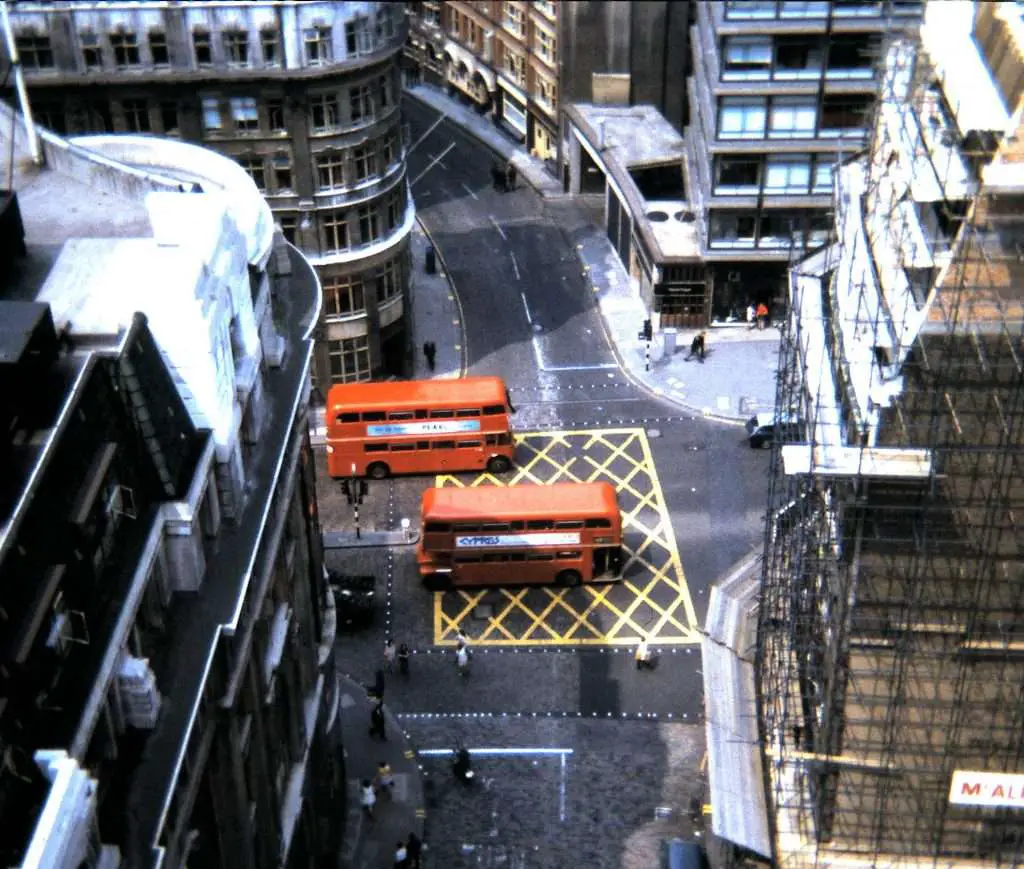
Box junctions, marked with yellow cross-hatching, were introduced in London during 1964. The aim was to prevent traffic blocking junctions when it could not proceed and this was successful.
Anti-Lock Braking System
Anti-lock braking systems were first developed for aircraft. An early system was Dunlop’s Maxaret system, introduced in the 1950s and still in use on some aircraft models. This was a fully mechanical system. It saw limited automobile use in the 1960s in the Ferguson P99 racing car, the Jensen FF and the experimental all wheel drive Ford Zodiac, but saw no further use; the system proved expensive and, in automobile use, somewhat unreliable. The first car (worldwide) to have ABS fitted as standard (across the entire range) was the Ford Granada Mk 3 (of 1985).The German firm Bosch had been developing anti-lock braking technology since the 1930s, but the first production cars using Bosch’s electronic system became available in 1978. They first appeared in trucks and the Mercedes-Benz S-Class. ABS Systems were later introduced on motorcycles.
Multi-Storey Car Park (UK)
The first multi-story car park in Britain was constructed in 1901 in Deman Street, just off Piccadilly Circus in central London. Also the world’s largest car park at the time, it covered more than 19,000 square feet and the six upper levels were reached via a hydraulic lift which was capable of raising a three-ton vehicle.
Double Mini-Roundabout (UK)
The first double mini-roundabout in Britain was installed at Upton Cross in Dorset in June 1970.
Drive-thru Restaurant
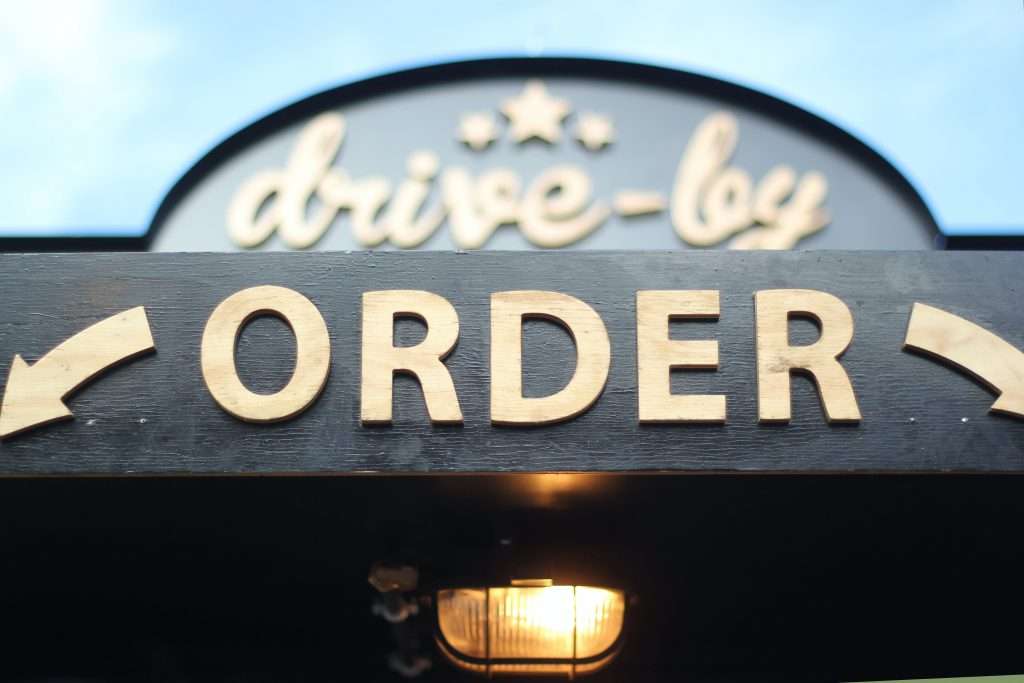
The first drive-thru restaurant was created in 1947 by Sheldon “Red” Chaney, operator of Red’s Giant Hamburg in Springfield, Missouri. Located on the famous Route 66, the restaurant served customers until its closure in 1984.’,
Motel (Britain)
Britain’s first motel, the Royal Oak, was opened in 1953 in Hythe, Kent.
Land’s End to John O’Groats Motor Trip
In October 1897 Henry Sturmey, Editor of Autocar, successfully drove a Coventry built Daimler with Mulliner body (of which he himself designed) from John o’ Groats to Lands End in order to promote the Daimler Company and demonstrate the cars durability. The actual running time over 99 miles was 93.5 hours, or nearly 10 mph average speed. Sturmey described the journey as trouble-free. Such chores as putting in new inlet valves, wiring lose tyres, taking links out of worn drive chains etc., were just part of the game!
Gas-turbine Powered Private Car
Rover unveiled the first car powered with a gas turbine engine in March 1950. JET1, a two-seater model was powered by the same kind of engine used in a jet, positioned behind the seats. The air intake grilles were on either side of the car and exhaust outlets on the top of the tail. During tests, the car reached top speeds of 90 miles an hour, with the engine running at 50,000 revs per minute.The Royal Automobile club recorded an acceleration speed of 0-60 (97km) in 14 seconds. The car ran on petrol, paraffin or diesel oil, but consumption was high – about five to seven miles a gallon (2 km to 2.5 km per litre). Rover and the BRM Formula 1 team joined forces to produce a gas turbine powered coupe, which entered the 1963 LeMans 24-hour race, driven by Graham Hill and Richie Ginther. It averaged 107.8mph (173km) and had a top speed of 142mph (229km). However, it proved difficult to build an engine small enough to fit in a car, which was also fuel efficient, so the gas turbine powered car was never going to be a viable alternative to the combustion engine.
Two-level Viaduct (UK)
Britain’s first two-level viaduct, the Tinsley Viaduct, opened in 1968, carries the M1 and the A631 1033 metres over the Don Valley, from Tinsley to Wincobank, also crossing the Sheffield Canal, the Midland Main Line and the former South Yorkshire Railway line from Tinsley Junction to Rotherham Central. Although originally designed to carry 6 lanes, during the strengthening work the M1 was permanently reduced to 4 lanes following an EU directive on load bearing capacity to allow for the introduction of 40-ton trucks in the UK. The viaduct is balanced on rollers to allow for thermal expansion and contraction, and the route weaves slightly in order to make its way past obstacles. The viaduct, due to its construction, is very flexible. Movement may be felt on the lower deck as the traffic passes overhead. The Meadowhall Shopping Centre lies in the valley to the west; to the east is the Blackburn Meadows sewage works.
Dual Four Lane Section of Motorway in Britain
One of the most complex interchanges in the country, Worsley Braided Interchange opened in 1970 to connect the then M62 (now M60) and M61 with the A580 and A666. It spans over 2.5 miles and featured the first lengths of dual four lane motorway in the UK. The M61 officially starts on the A580 with the links to the M60 forming part of the secretive A666(M). The distinctive pseudo-tunnels are an engineering solution to allow severely skewed carriageways to cross the mainline without the need for extensive support structures spanning the motorway. The southbound M61 suffers from severe congestion as traffic squeezes into a single lane to join the relatively empty three lanes from Bolton. It is not yet known if the proposals to add a fourth lane anti-clockwise on the M60 will also change this merge. The junction is also notable in that, where the M60 clockwise splits off a slip road for the M61, you can draw a line roughly East–West and count eighteen lanes of motorway running in parallel.
Crash Test Dummy
Crash test dummies have helped to make cars vastly safer than they used to be, but there are grim beginnings to this innovation. Researchers in 1930s America wanted to study how much force the human body could withstand, so threw a corpse down a lift shaft. Human bodies are still used in academic crash test studies today.
Purpose-Built Motoring Racing Venue
The Brooklands Circuit, in Surrey, was the first purpose-built motor racing venue, opening in June 1907. It featured a 4.43 km (2.75 mi) concrete track with high-speed banked corners. Brooklands was also a centre of the aviation industry, with Vickers setting up a factory and aerodrome there during World War I. The racing circuit was closed in 1939 as war-time aircraft production took over. Damage done to the track during World War II meant the track never reopened for racing.
Self-Powered Road Vehicle Race
The first prearranged match race of two self-powered road vehicles over a prescribed route occurred at 4:30 am on August 30, 1867, between Ashton-under-Lyne and Old Trafford, a distance of eight miles. It was won by the carriage of Isaac Watt Boulton, one of six he said he had run over the years, perhaps driven by his 22-year old-son, Philip. The race was against Daniel Adamson’s carriage, likely the one made for Mr. Schmidt and perhaps driven by Schmidt. The reports do not indicate who was driving, since both were violating the red-flag law then fully in force. Boulton’s carriage was developed from a scrapped John Bridge Adams light-rail vehicle. These were solid fired steam carriages. This event and the details of the vehicles were recorded in the contemporary press, The Engineer.
Electric Car
Scottish inventor Robert Anderson built the first electric vehicle on record between 1832 and 1839. The car looked like a carriage without a horse in front of it.
Motor Sports Club
The first motor sports club, the Automobile Club du France, was formed in 1895 out of the committee which had organised the Paris – Bordeaux – Paris Race.
Grand Prix
The first race to carry the title Grand Prix was run ay Pau in February 1901, and was won by Maurice Framan in a Panhard at an average speed of 46.1 mph.
Retractable Headlights
Retractable headlights were first seen on the 1936 Model 810 Cord. Unlike modern systems these had to be wound in and out manually.
Speed Hillclimb
The first speed hillclimb was held in January 1897, over a 3-mile course from Nice to La Turbie, near Monte Carlo, and formed the final stage of the race from Marselle to Nice. It was won by M Pary driving Andre Michelin’s 15hp De Dion Bouton steam car, which averaged just under 20 mph from an 18hp De Dion Bouton steamer driver by the Comte de Chasseloup-Laubat, and the 6hp petrol-driven Peugeot of Lemaitre, which took more than 20 minutes longer to complete the course than the winning car. The success of Michelin’s car over Chasseloup-Laubat’s similar but more powerful machine was attributed to the fact that the first was using pneumatic tyres, the second running on solid tyres.
Reversing Light
The first car to be offered with a reversing light was the American Willys-Sainte Claire, in 1921.
Gullwing Doors
Gullwing doors were first used on the Mercedes-Benz 300SL, unveiled in 1952, and put into production in 1954.
Car Fog Lights (Britain)
Britain’s first automobile fog lights were produced by Desmo of Birmingham in 1928. Previous to this accessory manufacturers offered ‘fog discs’ in yellow celluloid which fitted over the headlamp.
Traffic Signs (Britain)
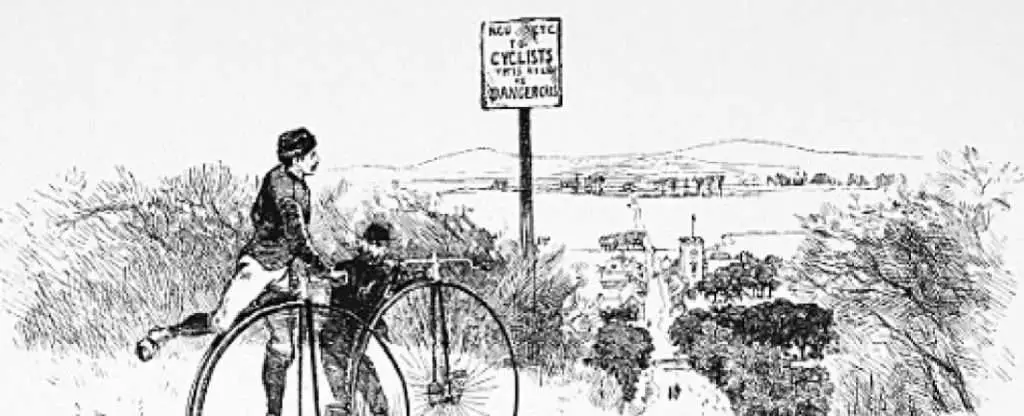
The first traffic signs were erected in Britain in December 1879. They were installed by the Bicycle Union and consisted of a wooden post with an enameled iron plate bearing the warning: “To cyclists – this hill is dangerous”. In 1901 the first signs directed specifically at motorcar drivers were introduced in Gloucester. The first internationally standardized signs (a red triangle surrounding a plate with an agreed symbol) were agreed upon in 1909 in France.
Sports Car
Most experts agree that Vauxhall built the first true sports car, the 1910 Prince Henry. It offered the race car thrills, but with much more civilised accommodation. It was a replica of the 3.0-litre car Vauxhall had successfully campaigned in the 1910 Motor Trial, a 1,200 mile race across Prussia. The Prince Henry – named after Prussia’s ruler – had further competition success, both in trials and at the Brooklands circuit. Few survive and are highly prized.
Bumper Sticker
According to Bloomberg columnist Stephen Carter (a Yale University Law School intellectual-property professor), the first bumper stickers appeared in the late 1920s to advertise products.
Car Heaters
The first heaters specifically designed for cars appeared in the after-market around 1907 and used a vehicle’s exhaust for warmth.Typically installed by plumbers, they’d use pipes to route exhaust gas through the car’s cabin to give off heat. But these systems often leaked, smelled bad and even caused some asphyxiation deaths. The earliest modern heating system appeared on some 1933 Fords. Using a heat exchanger, they safely transferred warmth from the car’s exhaust to fresh air that came out of a dashboard vent.
Car Bumper
Czech automaker Nesselsdorfer Wagenbau-Fabriksgesellschaft added bumpers to its “Prasident” model in 1897, but they\’re said to have fallen off after a short trip. British engineer Frederick R Simms, a friend of Mercedes-Benz co-founder Gottlieb Daimler, ultimately received the first patent for car bumpers in 1905.’,
Speedometer
New York inventor Joseph Jones created the first gauge to measure auto speed in 1899, dubbing his invention the “speedometer.” Jones developed the device after his wife asked while they were driving a steam-powered car he had built how fast they were going. When Jones admitted that he didn\’t know, she suggested he come up with a way to find out. He did so, patenting the speedometer in 1903 and reportedly making a fortune off of it.’,
Car Keys
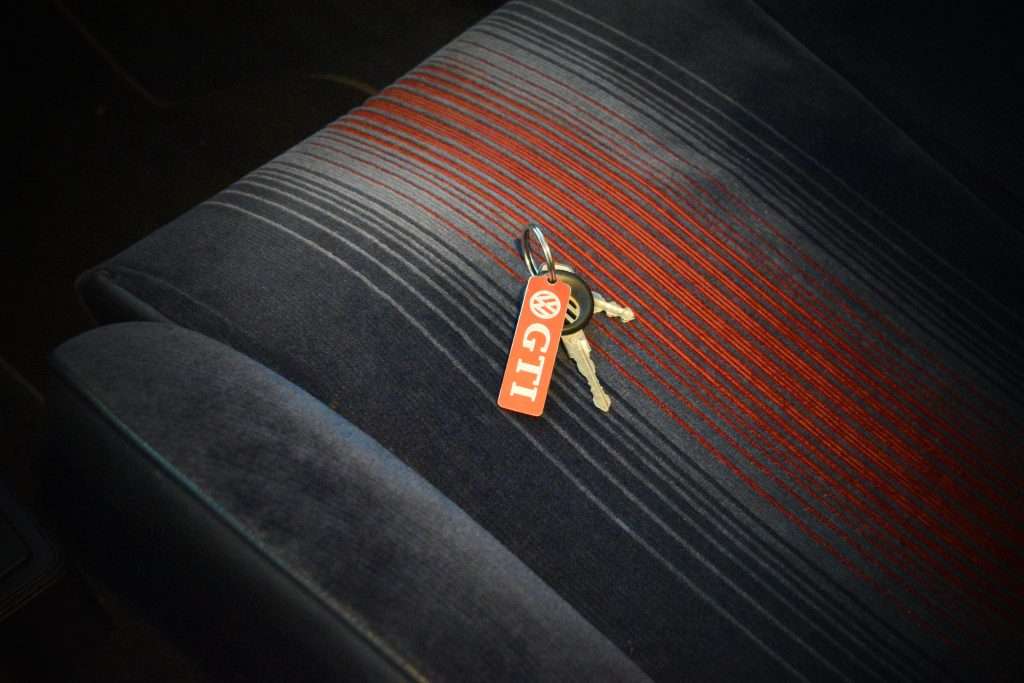
Making automobiles easier to start made them easier to steal, creating the need for car keys. Early electric starters just had push buttons, but one Indiana automaker included a key-controlled ignition switch on a 1914 model called the Inter-State. Car key ignitions came into wide use in 1949, when Chrysler added them to all of its cars. Ironically, automakers have been going the other direction in recent years and replacing key-controlled ignitions with push-button ones on many models. But unlike the early systems, modern keyless ignitions won’t start unless you to have a special key fob that sends a signal to the auto to prove that you’re authorised to drive.
First Dual Carriageway (Britain)
The first dual carriageway was built in 1925 at the London end of the Great West Road. There was already a single carriageway road called the Great West Road bypassing Brentford and Hounslow which had been built in 1920. The addition of a second carriageway turned it into the first dual carriageway in Britain.
Dipstick
The first car with a dipstick to check oil was launched in 1915 – the Morris Cowley. Unlike many automobile inventions this one is still used, unchanged in nearly all cars
Touring Caravan (Britain)
The first commercial touring caravan emerged a year after World War I with the Eccles car-pulled caravan. Founded by Bill Riley and his son, Eccles Motor Transport essentially gave birth to modern British caravanning. Their first model was priced at £90 – a lot of money at the time.
Hydrogen Filling Station (Britain)
The UK’s first commercial hydrogen filling station opened in Swindon in 2011
Motoring Death
The first death by motoring happened on August 17, 1896, at the Crystal Palace, London, when Bridget Driscoll of Croydon was run over and her skull fractured by the wheel of the offending car. The driver (Arthur Edsell) was employed to give joy rides in a Rogers-Benz on the terrace of the Crystal Palace. Driscoll was crossing the road when she saw the automobile hurtling toward her at the speed of 4 mph. She took fright and stood still in the path of the oncoming car. The death was ruled accidental.
‘Conventional’ Motor Car
With a front-mounted vertical engine, foot operated friction clutch and sliding-pinion change-speed gear, the vehicle produced by Panhard et Levassor in Paris, in 1901, is generally considered to be the first ‘conventional’ motor car.
First British Designed Four-Wheeled Petrol Car
The Lanchester was the first British designed four-wheeled petrol car. Designed by Frederick Lanchester and built, with his brother George’s help, in Birmingham, in 1895, it was the first ever to be designed from first principles as a complete mechanical entity rather than as a assemblage of odds and ends. The first production-model Lancaster appeared in 1900.
Radial Tyres
The first successful radial-ply tyre was the Michelin “X”, marketed in 1853.
Snow Chains

Snow chains were invented in 1904 by Harry D. Weed in Canastota, New York. Weed received U.S. Patent Number 768495 for his “Grip-Tread for Pneumatic Tires” on August 23, 1904. Weed\’s great-grandson, James Weed, said that Harry got the idea of creating chains for tires when he saw drivers wrap rope, or even vines, around their tyres to increase traction on muddy or snowy roads, which were the norm at the turn of the 20th century. He sought to make a traction device that was more durable and would work with snow as well as mud.’,
Antilock Brakes
In 1968, Ford became the first automaker to offer an antilock brake system. Though the system did not sell in large volume, it did validate the technology and lead to more sophisticated antilock systems. In 1979, Mercedes-Benz introduced the first computerised antilock braking system.
Bus Lane (World)
According to the American Public Transportation Association (APTA) and the National Transit Database (NTD), the world’s first designated bus lane was created in Chicago in 1940.
Practical Roadside Breathalyser
In 1931 the first practical roadside breath-testing device was the drunkometer developed by Rolla Neil Harger of the Indiana University School of Medicine. The drunkometer collected a motorist’s breath sample directly into a balloon inside the machine. The breath sample was then pumped through an acidified potassium permanganate solution. If there was alcohol in the breath sample, the solution changed color. The greater the color change, the more alcohol there was present in the breath. The drunkometer was manufactured and sold by Stephenson Corporation of Red Bank, New Jersey.
Rumble Strips
Rumble strips, also known as sleeper lines, rumple strips, audible lines, “the corduroy”, and growlers, are a road safety feature to alert inattentive drivers of potential danger, by causing a tactile vibration and audible rumbling transmitted through the wheels into the vehicle interior. Rumble strips were first implemented on the Garden State Parkway in New Jersey in 1952.’,
Royal Motorist
Prince of Wales, later King Edward VII became the first “royal” motorist when he was driven in a Serpollet steam car belonging to Gaston Menier, the chocolate manufacturer, at Bad Homburg in the summer of 1905.
Turkish Car
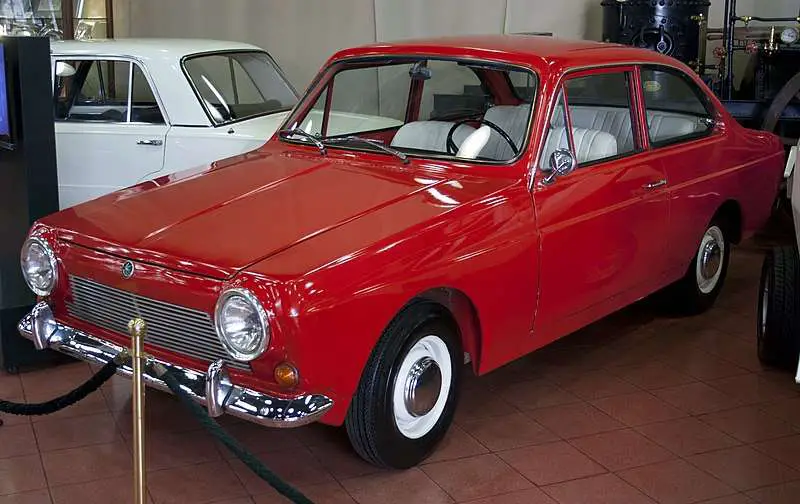
The Ford-engined Otosan Anadol of 1966, designed by Reliant of Tamworth, was the first Turkish private car.
British Company Formed to Produce Petrol Cars
Daimler was the first company formed in Britain to produce petrol motor cars, which was floated in December 1896 by a financier named Lawson who tried to establish a motor monopoly on Britain. Although the company was meant to manufacturer cars to the designs of the German Daimler company, whose English manufacturing license was acquired by Lawson, the first cars they made, in 1897, were copied from the French Panhard-Levassor design. The engines were of Daimler type as Panhard-Levassor were the licensees of Daimler patents.
200 mph Production Car
The first road legal production car to hit 200mph was the Ferrari F40. Although the Dodge Charger Daytona and Ford GT-40 which were around earlier could reach 200mph, neither of them were the same as their production car versions. They were race modified and therefore not counted as production car records.
200 mph Production Car
The first road legal production car to hit 200mph was the Ferrari F40. Although the Dodge Charger Daytona and Ford GT-40 which were around earlier could reach 200mph, neither of them were the same as their production car versions. They were race modified and therefore not counted as production car records.
Contraflow Bus Lane
The first contraflow bus lane in the UK was introduced in King’s Road, Reading as a temporary measure when the road was made one-way (eastwards to Cemetery Junction) on 16 June 1968. The initial reason was to save the expense of rerouting the trolleybus, which was due to be scrapped on 3 November of that year. However the experiment proved so successful that it was made permanent for use by motor buses.
Zebra Crossings

Zebra crossings for pedestrians were first introduced in Britain in October 1951. Although the origin of the name is disputed, it is generally attributed to British M.P. James Callaghan who, in 1948, visited the country’s Transport Research Laboratory, which was working, on a new idea for safe pedestrian crossings. On being shown a black and white design, Callaghan is said to have remarked that it resembled a zebra.
Veteran Car Auction
Southern Counties Car Auction staged the world’s first veteran and vintage car auction at the Montague Motor Museum in Beaulieu. On this occasion an open 1923 20 hp Rolls Royce made only £170 ($470)!
Motor Sports Club
The Automobile Club de France, the first motor sports club, was formed in 1895 out of the committee which had organised the Paris-Bordeaux-Paris Race.
Lamborghini
The first Lamborghini was a tractor built up of war-surplus Morris, Ford and General Motors bits and pieces, constructed in 1948 by Ferruccio Lamborghini.
Tow Truck

Ernest Holmes of Chattanooga, US invented the first tow truck in 1916 after needing blocks, ropes, and six men to pull a Motel T Ford out of a creek. Holmes assembled a system consisting of three poles, a pulley and a chain, all connected to the frame of a 1913 Cadillac. Holmes soon patented his invention, and began manufacturing the equipment to sell to garages and other interested customers out of a small shop on Chattanooga’s Market Street. The Holmes brand went on to earn an international reputation for quality in the towing industry.
First Turbocharged Production Car
General Motors manufactured the first turbocharged production cars in 1962 with the Turbo Jetfireengine used in the Oldsmobile Jetfire (a modified version of the turbocharger setup was also used in the Chevrolet Corvair Monza Spyder released a month later). A Garrett AiResearch turbocharger with integral wastegate was used. Power was significantly increased over the naturally aspirated (non-turbo) engine, however, reliability of these engines was poor and the production of the engine stopped in 1963.
US Presidential Car

The first car specially built for presidential use was the 1939 Lincoln V12 convertible called the “Sunshine Special”, used by Franklin D. Roosevelt. The limousine was originally equipped with a siren, running lights, a 2-way radio, extra-wide running boards, and grab handles for Secret Service agents.’,
Automatic Parking
The first production automatic parking system, the Intelligent Parking Assist System (IPAS), was developed by Toyota Motor Corporation in 1999 – initially for the Japanese market hybrid Prius and Lexus models. The technology assisted drivers in parking their vehicle. On vehicles equipped with the IPAS, via an in-dash screen and button controls, the car steers itself into a parking space with little input from the user. The first version of the system was deployed on the Prius Hybrid sold in Japan in 2003.
Directional Headlights
Directional headlights provide improved lighting for cornering. Some automobiles have their headlamps connected to the steering mechanism so the lights will follow the movement of the front wheels. Czech Tatra was an early implementer of such a technique, producing the Tatra 77 in 1937 with a central directional headlamp. The American 1948 Tucker Sedan was likewise equipped with a third central headlamp connected mechanically to the steering system.
Run Flat Tyre
In 1934, Michelin introduced a run flat tyre that was based on technology developed for local commuter trains and trolleys. It had a safety rim inside the tyre which if punctured would run on a special foam lining. The tyre was sold for military use and for specialised vehicles like bank armoured cars. It was advertised as “semi-bullet proof”. While the tyre performed as advertised it was far too expensive to be a feasible option for private automobile users.’,
Windscreen Washer
The first windscreen washer offered for automobiles was in 1936, as an aftermarket option to be installed on cars after they were bought.
Rain Sensing Windscreen Wipers
In March 1970, Citroën introduced rain-sensitive intermittent windscreen wipers on their SM model. When the intermittent function was selected, the wiper would make one swipe. If the windscreen was relatively dry, the wiper motor drew high current, which set the control circuit timer to delay the next wipe longest. If the motor drew little current, it indicated that the glass was wet, setting the timer to minimize the delay.
Flyover Junction
The first flyover junctions in Britain were on the Winchester By-pass, at the junctions with the Alton and Alresford roads, and with the old A33 road at Compton. The By-pass was opened in 1939.
Five Wheeled Car
The Smith Flyer of 1917, was the world’s first five-wheeled car. The fifth wheel incorporated a small air-cooled engine and took the drive. Very similar was a ‘car’ made by Briggs and Stratton in 1920.
Gas-Turbine Car
The prototype Rover two-seater (JET 1), built in 1949, was the world’s first gas-turbine-powered private car. JET1, an open two-seat tourer, had the engine positioned behind the seats, air intake grilles on either side of the car, and exhaust outlets on the top of the tail. t held a world speed record for a gas turbine powered car in 1952 with a speed of 152.691 mph. Rover won the Dewar Trophy in 1951 for this work, in recognition of its outstanding pioneering achievement.[2] It was the first time this trophy had been awarded since 1929.





